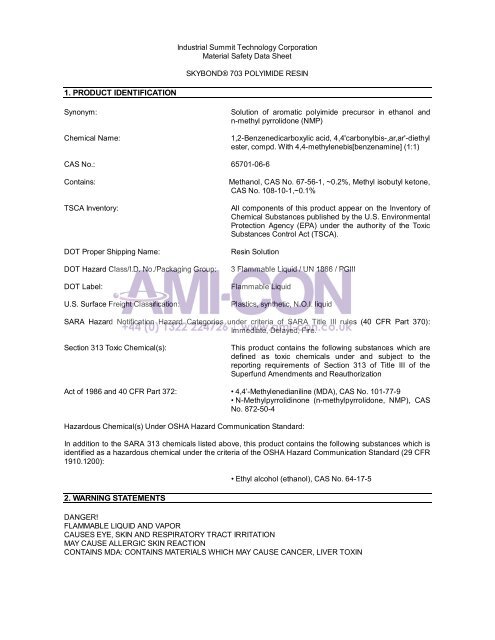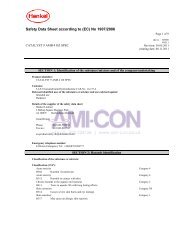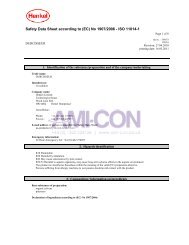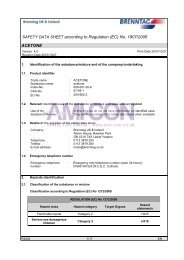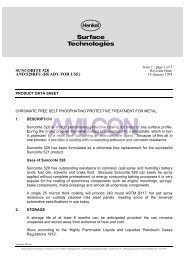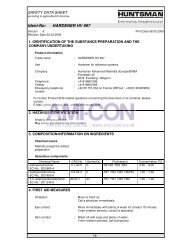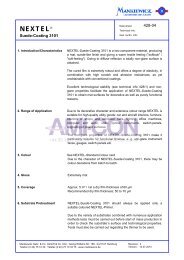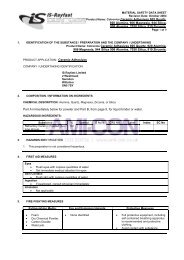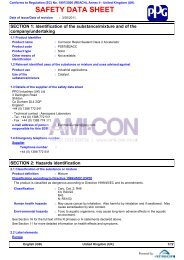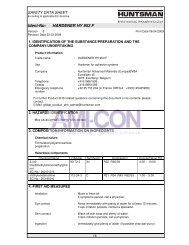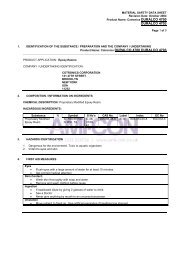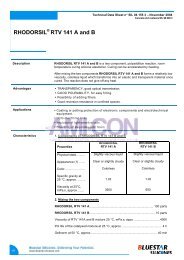Industrial Summit Technology Corporation Material ... - AMI-CON
Industrial Summit Technology Corporation Material ... - AMI-CON
Industrial Summit Technology Corporation Material ... - AMI-CON
You also want an ePaper? Increase the reach of your titles
YUMPU automatically turns print PDFs into web optimized ePapers that Google loves.
1. PRODUCT IDENTIFICATION<strong>Industrial</strong> <strong>Summit</strong> <strong>Technology</strong> <strong>Corporation</strong><strong>Material</strong> Safety Data SheetSKYBOND® 703 POLYIMIDE RESINSynonym:Chemical Name:Solution of aromatic polyimide precursor in ethanol andn-methyl pyrrolidone (NMP)1,2-Benzenedicarboxylic acid, 4,4'carbonylbis-,ar,ar'-diethylester, compd. With 4,4-methylenebis[benzenamine] (1:1)CAS No.: 65701-06-6Contains:TSCA Inventory:DOT Proper Shipping Name:DOT Hazard Class/I.D. No./Packaging Group:DOT Label:U.S. Surface Freight Classification:Methanol, CAS No. 67-56-1, ~0.2%, Methyl isobutyl ketone,CAS No. 108-10-1,~0.1%All components of this product appear on the Inventory ofChemical Substances published by the U.S. EnvironmentalProtection Agency (EPA) under the authority of the ToxicSubstances Control Act (TSCA).Resin Solution3 Flammable Liquid / UN 1866 / PGIIIFlammable LiquidPlastics, synthetic, N.O.I. liquidSARA Hazard Notification Hazard Categories under criteria of SARA Title III rules (40 CFR Part 370):Immediate, Delayed, Fire.Section 313 Toxic Chemical(s):This product contains the following substances which aredefined as toxic chemicals under and subject to thereporting requirements of Section 313 of Title III of theSuperfund Amendments and ReauthorizationAct of 1986 and 40 CFR Part 372: • 4,4’-Methylenedianiline (MDA), CAS No. 101-77-9• N-Methylpyrrolidinone (n-methylpyrrolidone, NMP), CASNo. 872-50-4Hazardous Chemical(s) Under OSHA Hazard Communication Standard:In addition to the SARA 313 chemicals listed above, this product contains the following substances which isidentified as a hazardous chemical under the criteria of the OSHA Hazard Communication Standard (29 CFR1910.1200):2. WARNING STATEMENTS• Ethyl alcohol (ethanol), CAS No. 64-17-5DANGER!FLAMMABLE LIQUID AND VAPORCAUSES EYE, SKIN AND RESPIRATORY TRACT IRRITATIONMAY CAUSE ALLERGIC SKIN REACTION<strong>CON</strong>TAINS MDA: <strong>CON</strong>TAINS MATERIALS WHICH MAY CAUSE CANCER, LIVER TOXIN
3. PRECAUTIONARY MEASURESKeep away from heat, sparks and flame.Use with adequate ventilation.Avoid contact with eyes, skin and clothing.Avoid breathing vapors.Keep container closed.Wash thoroughly after handling.<strong>CON</strong>TAINER HAZARDOUS WHEN EMPTY:Emptied containers resin vapor and product residue. FOLLOW LABELED WARNINGS EVEN AFTER<strong>CON</strong>TAINER IS EMPTIED. RESIDUAL VAPORS MAY EXPLODE ON IGNITION. DO NO CUT, DRILL,GRIND OR WELD ON OR NEAR THIS <strong>CON</strong>TAINER. Improper disposal or reuse of this container may bedangerous and/or illegal.4. EMERGENCY AND FIRST AID PROCEDURESFIRST AID:IF IN EYES,IF ON SKIN,IF INHALED,immediately flush with plenty of water for at least 15 minutes. Get medical attention.Immediately wash with soap and plenty of water. Remove contaminated clothing. Getmedical attention. Wash clothing before reuse.remove to fresh air. If not breathing, give artificial respiration. If breathing is difficult, giveoxygen. Get medical attention. Remove material from eyes, skin and clothing.IN CASE OF:FIRE,SPILL OR LEAK,use water spray, dry chemical, foam or carbon dioxide.flush area with water spray (see "Spill, Leak & Disposal Information" section).5. OCCUPATIONAL <strong>CON</strong>TROL PROCEDURESEye Protection:Skin Protection:Attention!Respiratory Protection:Ventilation:Where there is significant potential for eye contact, wear chemical gogglesand have eye flushing equipment available.Wear appropriate protective clothing and chemical resistant gloves toprevent skin contact. Consult glove manufacturer to determine type ofglove for given application. Wear chemical safety glasses, a face shieldand a chemical apron when splashing is likely. Wash immediately if skin iscontaminated. Remove contaminated clothing promptly and launderbefore reuse. Clean protective equipment before reuse. Provide a safetyshower at any location where skin contact can occur. Wash thoroughlyafter handling.Repeated or prolonged contact may cause allergic skin reaction in somepeople.Avoid breathing vapor and/or mist. Use NIOSH/MSHA approvedrespiratory protection equipment (full facepiece recommended) whenairborne exposure limits (see below) are exceeded. If used, full facepiecereplaces need for face shield and Chemical goggles. Consult respiratormanufacturer to determine appropriate type equipment for givenapplication. Observe respirator use limitations specified by NIOSH/MSHAor the manufacturer. Respiratory protection programs must comply with29 CFR 1910.134.Provide natural or mechanical ventilation to control exposure levels belowairborne exposure limits (see below). If practical, use local mechanical
exhaust ventilation at sources of air contamination such as open processequipment. Consult NFPA Standard 91 for design of exhaust system.Airborne Exposure Limits:Product:SKYBOND® 703 polyimide resinOSHA PEL: None establishedACGIH TLV: None establishedComponent: n-Methylpyrrolidone wt. % ~33OSHA PEL: None establishedACGIH TLV: None establishedIST Corp. has adopted, for its own internal use, an exposure limit 2ppm (8 mg/m 3 ), 8-hour time- weightedaverage (Skin)* for n-methylpyrrolidone.Component: Ethanol wt. % ~5OSHA PEL: 1000ppm 8-hour time-weighted averageACGIH TLV: 1000ppm 8-hour time-weighted averageComponent: 4,4’-Methylenedianiline wt. % ~13OSHA PEL: 10ppb 8-hour time-weighted averageACGIH TLV: 0.1ppm 8-hour time-weighted average – Skin*The ACGIH has designated 4,4’-Methylenedianiline an "A2" substance, thereby including4,4’-Methylenedianiline among industrial substances suspect of carcinogenic potential for man. Workerexposure by all routes should be carefully controlled.*Skin notation means that skin absorption of this material may add to the overall exposure. Avoid skin contact.6. FIRE PROTECTION INFORMATIONFlash Point: 76°FMethod:Extinguishing Media:Special Firefighting Procedures:Unusual Fire and Explosion Hazards:Pensky-Martens, Closed CupWater spray, dry chemical, foam, carbon dioxide or any Class Bextinguishing agent.Firefighters and others who may be exposed to products ofcombustion (see "Hazardous Decomposition Products", below)should wear full protective clothing and self-contained breathingapparatus. Thoroughly decontaminate equipment after use.Closed containers exposed to heat may build up pressure. Usewater spray to keep exposed containers and equipment cool.7. REACTIVITY DATA<strong>Material</strong>s To Avoid:Conditions To Avoid:Hazardous Decomposition Products:Hazardous Polymerization:Strong oxidizing and reducing agents.Do not expose to heat or ignition sources. Volatiles given off duringcure – ethanol, n-methylpyrrolidone.Carbon monoxide, nitrogenous products.Does not occur.8. HEALTH EFFECTS SUMMARYThe following information summarizes human experience and the results of scientific investigations reviewedby health professionals for hazard evaluation of Skybond® 703 polyimide resin solution and development of
Precautionary Measures and Occupational Control Procedures recommended in this document.Effects of ExposureInhalation and skin contact are expected to be the primary routes of occupational exposure to SKYBOND®703 polyimide resin. Occupational exposure to this material has not been reported to cause significantadverse human health effects. However, this material is considered to cause eye burns based on animalstudies. The organic solvents described below have been reported to cause eye, skin and respiratory tractirritation and may contribute to the irritancy of this material. These solvents also possess narcotic-likeproperties; excessive exposure may result in headache, dizziness, incoordination, nausea, loss of appetiteand loss of consciousness.4,4’-Methylenedianiline (MDA) may be present in free or partially reacted form (salts) in this SKYBOND resin.MDA has been reported to cause eye, skin and respiratory tract irritation. Reversible liver damage (hepatitis)has occurred in humans occupationally exposed to MDA. Symptoms include severe pain in the upperabdomen, high fever and chills and subsequent jaundice (yellowing of the eyes and skin). These symptomsmay be delayed several days following exposure. Although infrequent, allergic skin reaction has beenreported in humans animals following repeated or prolonged contact with MDA. Laboratory animals have alsodemonstrated allergic skin reaction following MDA exposures.Toxicological DataData from I.S.T Corp. studies indicate are given below.Single-dose (acute) animal studies indicate:Oral:Slightly Toxic (Rat LD50 – 4,470 mg/kg)Dermal:Practically Nontoxic (Rabbit LD50 -> 10,000mg/kg)Eye Irritation:Moderately Irritating (Rabbit, 21.2/110.0)Skin Irritation:Practically Nonirritating (Rabbit, 0.5/8.0, 24-hr. exp.)No allergic skin reaction was observed in guinea pigs following repeated skin exposure to SKYBOND 703polyimide resin. Studies with rats exposed to SKYBOND 703 by repeated skin application (4 weeks) reporteddecreased body weights, enlarged thyroid glands, serum chemistry changes, kidney effects and thyroidchanges. Genetic changes were reported in standard tests with bacterial cells; however, no adverse geneticchanges were observed in standard tests with animal and animal cells.ComponentsData from the available scientific literature on the components of SKYBOND 703 polyimide resin which havebeen identified as hazardous chemicals under the criteria of the OSHA Hazard Communication Standard (29CHR 1910.1200) are discussed below:4,4’-Methlenedianiline (MDA)Single-dose (acute) animal studies indicate that MDA is slightly toxic orally (rats). Rabbits, cats and dogsdisplayed liver and kidney damage following single oral doses of MDA at low to moderate levels. Numerousstudies report liver damage in laboratory animal from repeated exposure to MDA by various routes includingskin implantation (rats), dietary feeding (rats, dogs), skin application (rabbits) and short and long-term oraladministration (rats, mice, dogs).Kidney changes were also reported in rats and mice given MDA in their drinking water for 2 years. MDA hasproduced tumors (liver, kidney, thyroid) in rats and mice following long-term oral administration; however, noincrease in bladder or liver tumors were observed in dogs given MDA in their feed for 7 years. Geneticchanges were reported in standard tests using animal and bacterial cells, yeast and animals. No adversegenetic changes were reported in standard tests using insects and human cell cultures.4,4’-Methlenedianiline is listed as a substance that "may reasonably be anticipated to be carcinogenic" by theNational Toxicology Program (NTP) in their Sixth Annual Report on Carcinogens, and is classified as "possiblycarcinogenic to humans" by the International Agency for Research on Cancer (IARC Monographs, Vol. 39),and is regulated as a carcinogen by OSHA (29 CFR 1910.1050). The NTP listing is based, in part, on their
determination that "there is sufficient evidence for the carcinogenicity of 4,4’-methylenedianiline inexperimental animals". The IARC listing is based on their determination that "there is sufficient evidence forthe carcinogenicity of MDA I humans and limited evidence for the carcinogenicity of MDA in experimentalanimals". The OSHA listing is also based on the animal data and a NIOSH report which associated elevatedbladder cancer risk with workers exposed to MDA, although OSHA concluded that the evidence in humans"was not conclusive".n-Methylpyrrolidone (NMP)Human experience indicates that continued or gross skin contact with NMP produces irritation, redness anddefatting of the skin. Inhalation of very high concentrations of NMP may result in headache, giddiness,nausea and mental confusion. Repeated dosing of laboratory animals with NMP has been reported to causechanges in organ weights and blood composition, reduced response to sound, and breathing difficulty at adosage which produced death. No skin allergy was observed in guinea pigs following repeated skin exposure.Long-term inhalation (2 years) of NMP produced no increase in tumors in rats and NMP did not show tumorinitiating activity in a mouse skin painting study. Birth defects were reported following dermal application ofNMP to rats at amounts which produced adverse effects on the mother and following intraperitoneal injectionin two strains of mice. No birth defects were reported in rats exposed to NMP by inhalation. No effects wereseen on the ability of rats to reproduce when exposed to NMP for two successive generations, although toxiceffects were reported in offspring at levels which produced adverse effects on the mother. NMP has producedno genetic changes in standard tests using animal and bacterial cells.EthanolIn addition to the irritating effects noted above, swallowing of ethanol also causes nervous system effects andgastrointestinal tract effects; substantial amounts may cause respiratory failure leading to death. Other effectsof ethanol related to repeated intake of alcoholic beverages include nutritional deficiencies, pancreas and liverdamage and blood cell changes. Repeated consumption of ethanol (alcoholic beverages) by pregnant womenis reported to produce adverse effects on the development of their offspring ("fetal alcohol syndrome")Single-dose studies indicate that ethanol is practically nontoxic orally (rats) and after skin application (rabbits)or after inhalation (rats). It is mildly to severely irritating to rabbit eyes and practically nonirritating tomoderately irritating to rabbit skin. It is practically nontoxic by inhalation (rat, LC50 - 20,000 ppm, 10 hourexposure). Various morphological functions and biochemical changes in heart muscle, liver, CNS and bloodcells have been reported for experimental animals given ethanol orally. Repeated inhalation exposuresproduced liver damage in rabbits, while other treatment-related effects were reported in pigs, dogs andmonkeys. Rats exposed by skin application to a 50% solution of ethanol showed only temporary skin irritation.Several species of laboratory animals have been exposed to ethanol by various routes to determine effects onoffspring. While susceptibility varies with each species, birth defects have been consistently reported in manyof the species tested (mouse, rat, pig, guinea pig, monkey). Ethanol produced genetic changes in standardtests using human volunteers and animals and yeast cells. No genetic changes were reported in standardtests using bacterial or animal cells, and negative responses were reported in assays using human cells.Ethanol is listed as a substance which is "carcinogenic to humans" by the International Agency for Researchon Cancer (IARC Monographs Vol. 44). This IRAC listing is based on their determination that althoughinadequate evidence exists for the carcinogenicity of ethanol and alcohol beverages in animals, sufficientevidence exists for the carcinogenicity of alcoholic beverages following long-term consumption of alcoholicbeverages. Epidemiological studies report increased incidence of mouth and throat cancer in humans afterlong-term consumption of alcoholic beverages. Higher risk is associated with the drinking of dark liquors andfor smokers who consume alcoholic beverages.Additional InformationThreshold Limit Value (TLVs) has been established by the American Conference of Governmental <strong>Industrial</strong>Hygienists for ethanol, one of the organic solvents used in SKYBOND 703 polyimide resin, and formethylenedianiline, which may be present as residual monomer in this resin solution. For further informationon these materials, please refer to the current edition on the Documentation of Threshold Limit Values andBiological Exposure Indices.
9. PHYSICAL DATAAppearance:Odor:Solubility in Water:Brown viscous liquidAmine-likeSlightSpecific Gravity (H 2 O = 1): 1.15 – 1.18Vapor Density: 3.23Brookfield Viscosity: 3,000 - 7,000 cps at 25°CVapor Pressure (mm Hg): 9Solid after Cure (1.0±0.1g, 288°C at 1hr): 48 – 52%Note:These physical data are typical values based on material tested but may vary from sample to sample. Typicalvalues should not be construed as a guaranteed analysis of any specific lot or as specifications for theproduct.10. SPILL, LEAK & DISPOSAL INFORMATIONWaste Disposal:SKYBOND® 703 polyimide resin is a "hazardous waste" as that term is defined in the Resource Conservationand Recovery Act (RCRA), 40 CFR 261, "Identification and Listing of Hazardous Waste", due to itscharacteristics of ignitability. Disposal via incineration is required by regulation, Disposal should be inaccordance with all applicable local, state and federal laws and regulations. Consult your attorney orappropriate regulatory officials for information on such disposal.Spill or Leakage Procedures:Remove any source of sparks, flame or hot surfaces. Insure adequate ventilation. Absorb spill withcommercial absorbing materials. Dispose of via authorized landfill procedures consistent with local, state andfederal regulations. Flush area with water. Keep out of sewers, water sheds, and water system. This productcontains an ingredient which meets the definition of "polycyclic organic matter" in Secton 112 of the Clean AirAct of 1990. The Comprehensive Environmental Response and Liability Act (CERCLA) requires any chemicalso listed to be identified as a "hazardous substance" and that an RQ of one pound be established untilsuperseded by EPA regulations. Because 13%of this product’s ingredients meet the "polycyclic organicmatter" definition, release of more than 7.5 lbs. of this National Response Center (1-800-424-8802).Notification of state authorities may also be required.For further information refer to DOT Emergency Response Guidebook, Guide #26.11. ENVIRONMENTAL EFFECTSEnvironmental Toxicity Information:I.S.T Corp. has not developed environmental toxicity information on SKYBOND 703 polyimide resin. However,data are available on SKYBOND 700 polyimide resin, a similar material:96-hr LC50 Bluegill Sunfish:96-hr LC50 Rainbow Trout:48-hr LC50 Daphnia magna:380 mg/l, Practically Nontoxic340 mg/l, Practically Nontoxic16 mg/l, Slightly ToxicDate: 7/9/96
Although the information set forth herein (herein after "Information") are presented in good faith and believedto be correct as of the date hereof, I.S.T. <strong>Corporation</strong> makes no representations as to the completeness oraccuracy thereof. Information is supplied upon the condition that the persons receiving same will make theirown determination as to its suitability for their purposes prior to use. In no event will I.S.T. <strong>Corporation</strong> beresponsible for damages of any nature whatsoever resulting from the use of or reliance upon Information.NO REPRESENTATIONS OR WARRANTIES, EITHER EXPRESS OR IMPLIED, OF MERCHANTIBILITY,FITNESS FOR A PARTICULAR PURPOSE OR OF ANY OTHER NATURE ARE MADE HEREUNDER WITHRESPECT TO INFORMATION OR THE PRODUCT TO WHICH INFORMATION REFERSEnd of MSDS


